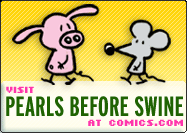those who do evil, but because of those who look on
and do nothing".
- Albert Einstein

Sunday, February 21, 2010
Pigs Use Mirrors to Find Hidden Food
Sunday, November 15, 2009
Pigs Prove to Be Smart, if Not Vain
We’ve all heard the story of the third Little Pig, who foiled the hyperventilating wolf by building his house out of bricks, rather than with straw or sticks as his brothers had done. Less commonly known is that the pig later improved his home’s safety profile by installing convex security mirrors at key points along the driveway.
Well, why not? In the current issue of Animal Behaviour, researchers present evidence that domestic pigs can quickly learn how mirrors work and will use their understanding of reflected images to scope out their surroundings and find their food. The researchers cannot yet say whether the animals realize that the eyes in the mirror are their own, or whether pigs might rank with apes, dolphins and other species that have passed the famed “mirror self-recognition test” thought to be a marker of self-awareness and advanced intelligence.
To which I say, big squeal. Why should the pigs waste precious mirror time inspecting their teeth or straightening the hairs on their chinny-chin-chins, when they could be using the mirror as a tool to find a far prettier sight, the pig heaven that comes in a bowl?
The finding is just one in a series of recent discoveries from the nascent study of pig cognition. Other researchers have found that pigs are brilliant at remembering where food stores are cached and how big each stash is relative to the rest. They’ve shown that Pig A can almost instantly learn to follow Pig B when the second pig shows signs of knowing where good food is stored, and that Pig B will try to deceive the pursuing pig and throw it off the trail so that Pig B can hog its food in peace.
They’ve found that pigs are among the quickest of animals to learn a new routine, and pigs can do a circus’s worth of tricks: jump hoops, bow and stand, spin and make wordlike sounds on command, roll out rugs, herd sheep, close and open cages, play videogames with joysticks, and more. For better or worse, pigs are also slow to forget. “They can learn something on the first try, but then it’s difficult for them to unlearn it,” said Suzanne Held of the University of Bristol. “They may get scared once and then have trouble getting over it.”
Researchers have also found that no matter what new detail they unearth about pig acumen, the public reaction is the same. “People say, ‘Oh yes, pigs really are rather clever, aren’t they?’ ” said Richard W. Byrne, a professor of evolutionary psychology at the University of St. Andrews. “I would recommend that somebody study sheep or goats rather than pigs, so that people would be suitably impressed to find out your animal is clever.” His feigned frustration notwithstanding, he added, “if you want to understand the evolution of intelligence and social behaviors, it’s important to work on animals like pigs that are not at all closely related to us” but rather are cousins of whales and hippos.
So far, and yet so near. Last week, an international team of biologists released the first draft sequence of the pig genome, the complete set of genetic instructions for making the ruddy-furred Duroc breed of Sus scrofus. Even on a cursory glance, “the pig genome compares favorably with the human genome,” said Lawrence Schook of the University of Illinois at Urbana-Champaign, one of the team leaders.
“Very large sections are maintained in complete pieces,” he said, barely changed in the 100-million-plus years since the ancestors of hogs and humans diverged.
Dr. Schook is particularly eager to see if the many physiological and behavioral parallels between humans and pigs are reflected in our respective genomes. Pig hearts are like our hearts, he said, pigs metabolize drugs as we do, their teeth resemble our teeth, and their habits can, too. “I look at the pig as a great animal model for human lifestyle diseases,” he said. “Pigs like to lie around, they like to drink if given the chance, they’ll smoke and watch TV.”
Pigs have been a barnyard staple for at least 8,000 years, when they were domesticated from the wild boar in Asia and Europe. Domestication was easy, given that they loved to root around in dump sites. “The pigs were hard to hunt, but if you put the garbage out, a lot of them would be drawn out from the woods,” Dr. Schook said. “After a while, people realized, we don’t have to hunt them. All we have to do is put a fence around our garbage.”
Pigs were tireless composting machines. “They fed on our scraps,” Dr. Byrne said. “Everything we produced, they turned into good meat.” Pork is among the world’s most popular meats; in many places, pigs are a valuable form of currency. “In parts of New Guinea, they’re so important to villages that they’re suckled by people,” he said.
Of course, pigs aren’t always handled so lovingly, and these researchers denounced factory farms. “I’m German and I love sausage, but I would never eat pork that isn’t free range,” Dr. Held said.
Even in domesticity, pigs have retained much of their foreboar’s smarts. Dr. Byrne attributes pig intelligence to the same evolutionary pressures that prompted cleverness in primates: social life and food. Wild pigs live in long-term social groups, keeping track of one another as individuals, the better to protect against predation. They also root around for difficult food sources, requiring a dexterity of the snout not unlike the handiness of a monkey.
Because monkeys had been shown to use mirrors to locate food, Donald M. Broom of the University of Cambridge and his colleagues decided to check for a similar sort of so-called assessment awareness in pigs. They began by exposing seven 4-to-8-week-old pigs to five-hour stints with a mirror and recording their reactions. The pigs were fascinated, pointing their snouts toward the mirror, hesitating, vocalizing, edging closer, walking up and nuzzling the surface, looking at their image from different angles, looking behind the mirror. When the mirror was placed in their pen a day later, the glass-savvy pigs greeted it with a big ho-hum.
Next, the researchers put the mirror in the enclosure, along with a bowl of food that could not be directly seen but whose image was reflected in the mirror. They then compared the responses of the mirror-experienced pigs with a group of mirror-naïve pigs. On spotting the virtual food in the mirror, the experienced pigs turned away and within an average of 23 seconds had found the food. But the naïve pigs took the reflection for reality and sought in vain to find the bowl by rooting around behind the mirror. No doubt the poor frustrated little pigs couldn’t wait to get home, crack open a beer and turn on the TV.
Wednesday, September 2, 2009
Another Victory for Pigs in Canada
From the web site of the Physicians' Committee for Responsible Medicine (PCRM).
---------------------------------------------------
Life continues to improve for pigs in Canada. In July, PCRM announced an Advanced Trauma Life Support win for pigs in Toronto. Now, the University of Saskatchewan College of Medicine announced that it too will stop using live pigs in its program and exclusively use the TraumaMan System.
PCRM planned to file a complaint on Sept. 2 with the Canadian Council on Animal Care (CCAC) against the University of Saskatchewan. It urged officials to end the use of pigs in upcoming trauma training courses because it violated Canada’s national animal welfare standards.
But PCRM’s senior medical and research adviser John Pippin, M.D., recently learned that the university purchased and received one TraumaMan System and will rent a second. The TraumaMan System will replace the use of animals in the university’s Advanced Trauma Life Support (ATLS) program. The university’s decision was covered by Canwest, the largest media company in Canada, and was reported in newspapers and TV stations across the country.
“The use of live pigs at the University of Saskatchewan undoubtedly caused pain and distress, and there was no valid justification for using live animals,” says Dr. Pippin. “The university’s decision to purchase the TraumaMan System underscores what 95 percent of ATLS programs already know: nonanimal teaching methods offer a more effective—and more humane—way to teach lifesaving procedures.”
Prior to the planned September complaint, Dr. Pippin sent three letters to the head of the trauma training program, Paul Hayes, F.R.C.S.C., that went unanswered, although he acknowledged seeing the letters. In the letters, Dr. Pippin asked that Dr. Hayes stop killing pigs in its trauma training program and switch to superior nonanimal training methods.
The win follows PCRM’s recent success at Sunnybrook Health Sciences Centre in Toronto, which stopped using animals and now exclusively uses the TraumaMan System.
But there’s still plenty of work to do in Canada and the United States. This summer, PCRM argued that Vanderbilt University Medical Center’s use of live pigs in a July trauma training course violated the federal Animal Welfare Act. ATLS training conducted at Vanderbilt University in Tennessee involves cutting into live, anesthetized pigs and practicing emergency medical procedures. Effective nonanimal training methods have been approved by the American College of Surgeons, the body overseeing these courses.
Vanderbilt is one of the last institutions in the country using animals in such courses. Lifelike human patient simulators or human cadavers are used at 95 percent of U.S. and Canadian facilities providing ATLS training.
But you can contact Vanderbilt’s dean of the school of medicine Jeffrey R. Balser, M.D., Ph.D., today and politely ask him to end animal use in the institution’s ATLS program before the October course.
To find learn more about ending animal use in ATLS programs, please visit HumaneTraumaTraining.org. Then join our Humane Trauma Training cause on Facebook.







